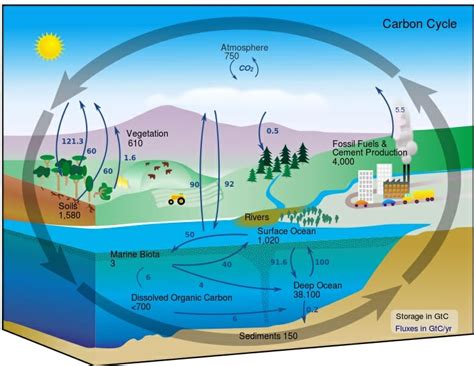Understanding the Distribution of Carbon
Carbon, a fundamental element in the Earth’s chemistry, exists in a variety of forms and reservoirs. Understanding its distribution is vital in comprehending the dynamics of the carbon cycle and addressing climate change concerns.

Oceans as the Primary Reservoir
The oceans serve as the largest reservoir of carbon on Earth, holding an estimated 36,300 gigatons (Gt) of carbon. This vast repository of dissolved inorganic carbon (DIC) and organic carbon plays a critical role in marine ecosystems and global carbon sequestration.
Terrestrial Ecosystems and the Soil Carbon Pool
Terrestrial ecosystems, including forests, grasslands, and wetlands, contain approximately 2,200 Gt of carbon. The soil carbon pool, a major component of terrestrial carbon, is comprised of organic matter in various stages of decomposition. Soil carbon sequestration helps mitigate climate change by capturing and storing carbon dioxide from the atmosphere.
Fossil Fuel Reservoirs: A Finite Source
Fossil fuel reservoirs, consisting of coal, oil, and natural gas, are significant sources of carbon. These reservoirs hold an estimated 5,000 Gt of carbon, representing a finite and non-renewable resource. Combustion of fossil fuels releases large amounts of carbon dioxide into the atmosphere, contributing to global warming.
The Atmospheric Carbon Pool
The atmosphere contains a relatively small amount of carbon, approximately 750 Gt. However, this pool is highly dynamic, exchanging carbon with terrestrial and marine ecosystems through processes such as photosynthesis and respiration. Understanding the balance between atmospheric carbon sources and sinks is essential for climate modeling.
The Importance of Carbon Reservoirs
1. Climate Regulation:
Carbon reservoirs act as regulators of atmospheric carbon dioxide levels, influencing global climate patterns. Changes in the distribution of carbon between reservoirs can impact temperature and precipitation patterns.
2. Biogeochemical Cycling:
Carbon reservoirs facilitate biogeochemical cycling, the processes that transform and transport carbon through the Earth’s systems. Understanding these cycles is crucial for assessing the environmental impact of human activities.
3. Carbon Sequestration:
Carbon reservoirs have the potential for carbon sequestration, the capture and storage of carbon dioxide from the atmosphere. Enhancing carbon sequestration in oceans, forests, and soils can mitigate climate change.
Carbon Reservoir Management Strategies
Managing carbon reservoirs is essential to address climate change and ensure environmental sustainability. Effective strategies include:
1. Afforestation and Reforestation:
Planting trees and restoring forests increases carbon sequestration capacity and reduces atmospheric carbon dioxide levels.
2. Soil Carbon Sequestration:
Implementing agricultural practices that promote soil health, such as cover cropping and no-till farming, enhances soil carbon storage.
3. Carbon Capture and Storage:
Technologies that capture carbon dioxide from industrial processes and store it below ground provide a promising solution for reducing emissions.
Conclusion
The oceans, terrestrial ecosystems, fossil fuel reservoirs, and the atmosphere constitute the main reservoirs of carbon on Earth. Understanding their distribution and dynamics is crucial for addressing climate change and ensuring environmental stewardship. By implementing effective carbon reservoir management strategies, we can mitigate the impacts of human activities and promote a sustainable future.
Comparison of Carbon Reservoirs
| Reservoir | Amount of Carbon (Gt) | Importance |
|---|---|---|
| Oceans | 36,300 | Primary carbon reservoir, regulates climate |
| Terrestrial ecosystems | 2,200 | Carbon sequestration, supports biodiversity |
| Fossil fuel reservoirs | 5,000 | Finite resource, major source of carbon dioxide emissions |
| Atmosphere | 750 | Dynamic pool, exchanges carbon with other reservoirs |
Pros and Cons of Carbon Reservoirs
Oceans
Pros:
* Vast carbon storage capacity
* Potentially enhanced carbon sequestration through ocean fertilization
* Supports marine ecosystems and biodiversity
Cons:
* Ocean acidification due to increased carbon dioxide absorption
* Potential for methane release from deep-sea sediments
Terrestrial ecosystems
Pros:
* Carbon sequestration and storage in soils and biomass
* Regulates climate and provides habitat
* Supports biodiversity and ecosystem services
Cons:
* Deforestation reduces carbon sequestration
* Soil erosion and degradation release carbon
* Vulnerable to climate change impacts
Fossil fuel reservoirs
Pros:
* Provides energy and fuels
* Supports economic growth
Cons:
* Finite and non-renewable resource
* Combustion releases carbon dioxide, contributing to climate change
* Extraction and production can have environmental impacts
FAQs
1. What is the largest carbon reservoir on Earth?
The oceans hold the largest carbon reservoir on Earth, containing approximately 36,300 Gt of carbon.
2. How does carbon move between reservoirs?
Carbon moves between reservoirs through processes such as photosynthesis, respiration, and the weathering of rocks.
3. What activities can influence the distribution of carbon reservoirs?
Human activities such as deforestation, fossil fuel combustion, and agriculture can significantly alter the distribution of carbon reservoirs.
4. What are the potential impacts of changing carbon reservoir distribution?
Changing carbon reservoir distribution can impact climate patterns, sea level rise, and the availability of resources such as water and food.
5. What technologies are available to manage carbon reservoirs?
Carbon capture and storage, afforestation, and soil carbon sequestration are examples of technologies that can help manage carbon reservoirs.
6. What are the benefits of managing carbon reservoirs?
Managing carbon reservoirs can mitigate climate change, enhance biodiversity, and provide economic benefits.
